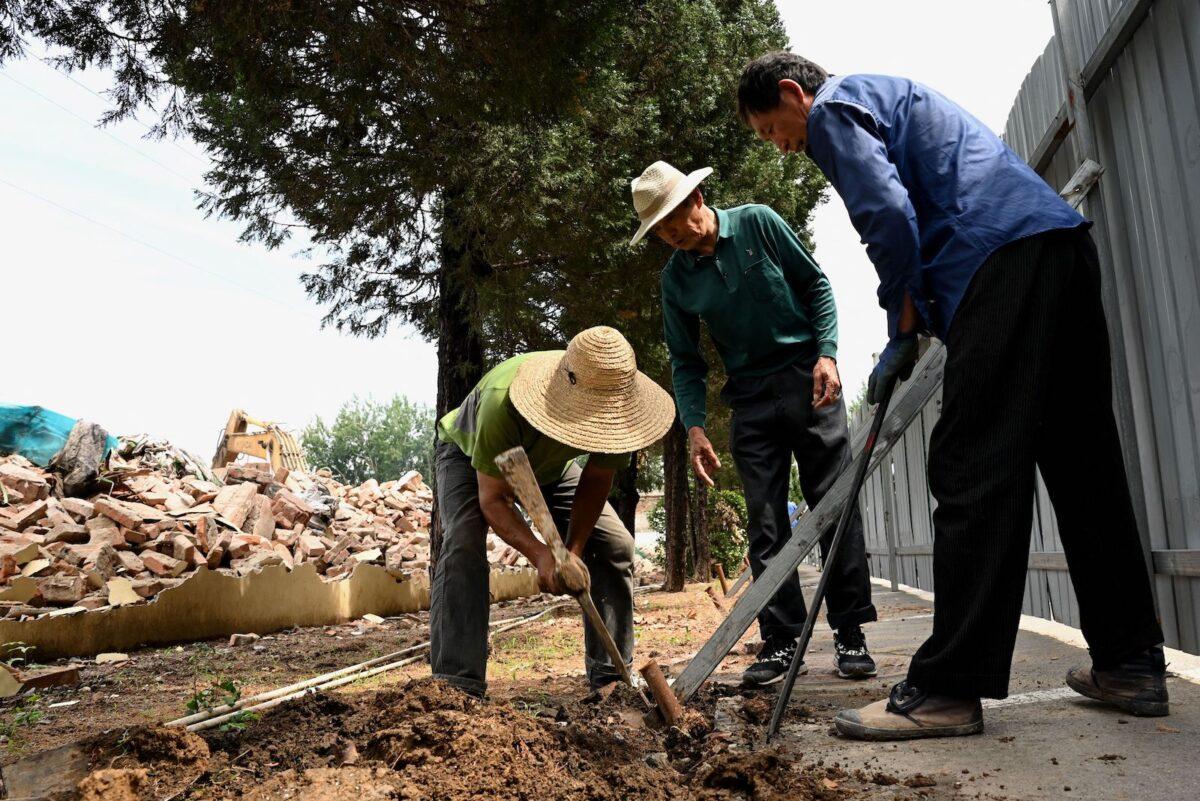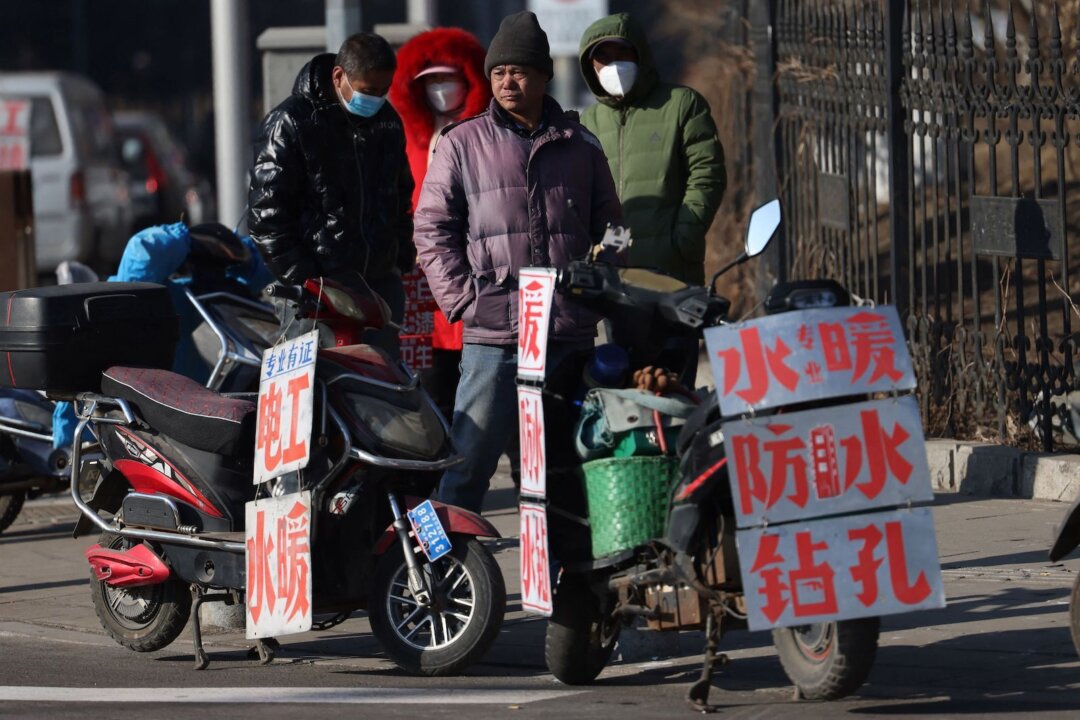The Chinese communist regime has rolled out measures to address the nation’s serious unemployment issues as trade tensions with the West continue.
Analysts pointed out that the effect of the measures is temporary and limited, with some being exploitative of the rural population, owing to the regime’s structural problems.
The regime’s State Council issued a notice on July 9 announcing a number of policy measures to “stabilize employment.” They include expanded social insurance subsidies, special loans, and targeted support for young people looking for jobs, among others.
In some regions, local governments will increase unemployment insurance refunds to a maximum of 90 percent from 60 percent for small and medium-sized enterprises and to 50 percent from 30 percent for large firms, according to the State Council’s notice.
Local government will give a one-time subsidy of no more than 1,500 yuan ($209) per unemployed youth to companies and organizations that hire registered unemployed people aged 16 to 24. The subsidy policy will be implemented until the end of December 2025, according to the notice.
According to the latest official statistics, in May, the unemployment rate was 14.9 percent in China among those aged 16 to 24, excluding students, while the nationwide urban unemployment rate was 5 percent. China’s youth unemployment crisis has persisted for years, with a record-high number of college graduates entering the job market every year. The trade tensions with the United States and European Union have exacerbated China’s unemployment problem, as many factories have suspended production because of increased tariffs and a sharp decline in exports.
As the Chinese regime has long been suspected of manipulating official statistics and underreporting data deemed unfavorable, some Chinese and international observers have estimated that the actual unemployment rate may be much higher.
According to analysts, the Chinese Communist Party (CCP) put out the measures trying to stop the vicious cycle–a surge in unemployment, which leads to a decline in consumption, a reduction in corporate orders, and further layoffs. However, they said the measures won’t be effective as China’s economic issues are rooted in its system.
The deep structural problems facing the Chinese economy, such as real estate risks, local government debt, and pressure from industrial transformation and upgrading, are difficult to solve with employment subsidies alone, Sun Kuo-hsiang, professor of international affairs and business at Nanhua University in Taiwan, told The Epoch Times on July 10.
“The uncertainty of external factors such as U.S.–China relations and the prospects for global economic recovery will continue to have an impact on China’s economy and employment,” he said.
“The problems, such as inefficiency and misappropriation of funds in the implementation of subsidy policies, will also affect their effectiveness.”
Sun said that if the overall market confidence continues to be low and companies are not willing to invest and expand production, it will be difficult to create a large number of new jobs with subsidies alone.
He noted that the subsidies announced this time “are mainly targeted at domestic enterprises and cannot directly enhance their competitiveness in the international market, especially when faced with tariff barriers.”
Many factories have suspended production, and businesses have gone bankrupt as the trade tensions continue with the United States and the EU. A large number of migrant workers from rural areas lost their jobs, and many of them have returned to their hometowns.
According to official data, in 2024, China had a rural population of 477 million and about 300 million migrant workers.
In China, the term migrant workers refers to the large number of Chinese rural residents who have gone to the cities to look for work. They constitute a massive workforce in China’s economic development, especially in manufacturing and construction. However, they don’t have urban household registration and therefore face significant challenges in the cities, including limited access to social services and welfare, discrimination, and difficulties in integrating into urban life.The State Council’s notice also includes the strengthening of the regime’s “work-for-relief” programs targeting the migrant workers who have lost their jobs in the cities in China’s sluggish economy.
The National Development and Reform Commission earlier this month issued a new investment of 10 billion yuan ($1.39 billion) for those programs in 26 provinces and cities to implement 1,975 small and medium-sized infrastructure projects. These targeted areas have a large number of migrant workers who returned home after losing their jobs in cities. The official claim is that the new investment can help 310,000 people find employment.

“Work-for-relief” refers to the policy of investing in infrastructure projects, where the beneficiaries participate in the construction of the projects and receive payment, replacing direct relief and support.
As of the end of June, China’s National Development and Reform Commission and the Ministry of Finance had invested a total of 29.5 billion yuan ($4.11 billion) in 2025 for the programs, supporting local governments in implementing nearly 6,000 projects, which are expected to absorb more than 700,000 unemployed people locally, and will pay more than 11 billion yuan ($1.53 billion) in remuneration for labor.
Sun said the programs are, at most, a Band-Aid approach.
“‘Work-for-relief’ provides mostly temporary or seasonal jobs and cannot provide stable, high-quality, long-term employment. The wages of these jobs are usually low,” he said.
For China’s unemployment crisis caused by structural problems, “‘work-for-relief’ can’t provide a fundamental solution,” according to Sun.
Frank Xie, a business professor at the University of South Carolina–Aiken, told The Epoch Times on July 9 that, based on the CCP’s measures to boost employment, “the Chinese economy seems to have fallen into a serious recession.”
Xie said that “work-for-relief” is the CCP’s “way to exploit migrant workers.”
“At this time, the CCP is still unwilling to directly distribute relief funds to those who need money, such as migrant workers, unemployed people, poor people, and rural laborers,” he said.
Instead, the regime “makes them work to earn a little relief money.”
“Now [the CCP is] actually using this method [to deal with the economic and unemployment crises], which was used more than half a century ago,” he said.
From the 1950s to the 1970s, work-for-relief was a common means used by the CCP in communist communes around the country, when poverty and hunger were widespread, according to public information.
Such programs do exist in countries around the world, and they also existed in ancient China, said Wang He, a U.S.-based China affairs observer.
But the CCP’s current practice is “very small in scale” and it’s “difficult to have a significant relief effect,” he told The Epoch Times on July 9. “It’s for show.”
Another challenge, Wang said, is that “the Chinese economy is in recession now, and a large number of migrant workers have returned to the countryside, but there is no work to do, which may cause social unrest.”
“In order to maintain the regime’s stability, the authorities have implemented the ‘work-for-relief,’” he said.

He noted that this indicates that “the CCP’s social assistance mechanism in rural areas is difficult to continue, and the absolute poverty problem in rural areas is still serious.”
Wang, echoing Xie’s point, compared China to democratic countries that take large-scale relief measures during times of disaster or emergency.
When the economy has been hit hard and a large number of people have lost their livelihood, he said, “the CCP still tries every means to make people work for it and squeeze more out of them.”
Wang also said the CCP’s measures likely won’t work because of rampant corruption.
“How much of these funds can actually reach the hands of the poor people remains a big question,” he said.
Luo Ya, Yi Ru, and Ning Haizhong contributed to this report.

